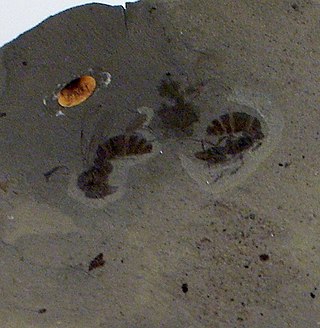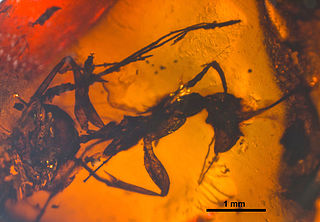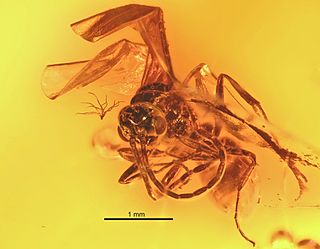
Prionomyrmex is an extinct genus of bulldog ants in the subfamily Myrmeciinae of the family Formicidae. It was first described by Gustav Mayr in 1868, after he collected a holotype worker of P. longiceps in Baltic amber. Three species are currently described, characterised by their long mandibles, slender bodies and large size. These ants are known from the Eocene and Late Oligocene, with fossil specimens only found around Europe. It is suggested that these ants preferred to live in jungles, with one species assumed to be an arboreal nesting species. These ants had a powerful stinger that was used to subdue prey. In 2000, it was suggested by Cesare Baroni Urbani that the living species Nothomyrmecia macrops and a species he described both belonged to Prionomyrmex, but this proposal has not been widely accepted by the entomological community. Instead, scientists still classify the two genera distinctive from each other, making Nothomyrmecia a valid genus.

Ypresiomyrma is an extinct genus of ants in the subfamily Myrmeciinae that was described in 2006. There are four species described; one species is from the Isle of Fur in Denmark, two are from the McAbee Fossil Beds in British Columbia, Canada, and the fourth from the Bol’shaya Svetlovodnaya fossil site in Russia. The queens of this genus are large, the mandibles are elongated and the eyes are well developed; a stinger is also present. The behaviour of these ants would have been similar to that of extant Myrmeciinae ants, such as solitary foraging for arthropod prey and never leaving pheromone trails. The alates were poor flyers due to their size, and birds and animals most likely preyed on these ants. Ypresiomyrma is not assigned to any tribe, and is instead generally regarded as incertae sedis within Myrmeciinae. However, some authors believe Ypresiomyrma should be assigned as incertae sedis within Formicidae.

Agroecomyrmex is an extinct genus of ants in the formicid subfamily Agroecomyrmecinae, for which it is the type genus. The genus contains a single described species, Agroecomyrmex duisburgi. Agroecomyrmex is known from a group of Middle Eocene fossils which were found in Europe.
Pristomyrmex rasnitsyni is an extinct species of ant in the genus Pristomyrmex. The species is known from a single Late Eocene fossil which was found in Europe.

Aphaenogaster sommerfeldti is an extinct species of ant in the subfamily Myrmicinae known from a group of Middle Eocene fossils found in Europe. A. sommerfeldti is one of three species in the ant genus Aphaenogaster to have been noted from fossils found in Baltic amber by William Morton Wheeler.

Aphaenogaster oligocenica is an extinct species of ant in the subfamily Myrmicinae known from a pair of Middle Eocene fossils found in Europe. A. oligocenica is one of three species in the ant genus Aphaenogaster to have been noted from fossils found in Baltic amber by William Morton Wheeler.

Aphaenogaster mersa is an extinct species of ant in the subfamily Myrmicinae known from a pair of Middle Eocene fossils found in Europe. A. mersa is one of three species in the ant genus Aphaenogaster to have been noted from fossils found in Baltic amber by William Morton Wheeler.

Archimyrmex is an extinct genus of ant in the formicid subfamily Myrmeciinae, described by palaeoentomologist Theodore Cockerell in 1923. The genus contains four described species, Archimyrmex rostratus, Archimyrmex piatnitzkyi, Archimyrmex smekali and Archimyrmex wedmannae. Archimyrmex is known from a group of Middle Eocene fossils which were found in North America, South America, and Europe. The genus was initially placed in the subfamily Ponerinae, but it was later placed in Myrmeciinae; it is now believed to be the ancestor of the extant primitive genus Myrmecia from Australia. Despite this, Archimyrmex is not a member to any tribe and is regarded as incertae sedis within Myrmeciinae. However, some authors believe Archimyrmex should be assigned as incertae sedis within Formicidae. These ants can be characterised by their large mandibles and body length, ranging from 13.2 to 30 mm. They also have long, thin legs and an elongated mesosoma (thorax) and petiole.

Asymphylomyrmex is an extinct genus of ants in the formicid subfamily Formicinae. The genus contains a single described species, Asymphylomyrmex balticus and is known from a group of Middle Eocene fossils which were found in Europe.

Emplastus is an extinct morphogenus of ants in the subfamily Dolichoderinae, known from fossils found in Asia and Europe. The genus contains twelve species described from sites in England, Eastern Europe and Far Eastern Russia.

Usomyrma is an extinct genus of ant in the formicid subfamily Dolichoderinae. The genus contains a single described species, Usomyrma mirabilis, that is known from two Middle Eocene fossils which were found in Scandinavian amber in Denmark.

Casaleia is an extinct genus of ants in the formicid subfamily Amblyoponinae described by Pagliano & Scaramozzino in 1990 from fossils found in Europe. The genus contains four species dating from the Eocene to Miocene, Casaleia eocenica, Casaleia inversa, Casaleia longiventris, Casaleia orientalis.

Zherichinius is an extinct genus of ants in the subfamily Dolichoderinae known from fossils found in amber from the Middle Eocene of Sakhalin island Far eastern Russia and Bitterfeld, Germany. At the time of description the species Zherichinius horribilis and Zherichinius rapax were two of eight ant species known from Sakhalin fossils.

Protopone is an extinct genus of ants in the formicid subfamily Ponerinae described from fossils found in Europe and Asia. There are seven described species placed into the genus, Protopone? dubia, Protopone germanica, Protopone magna, Protopone oculata, Protopone primigena, Protopone sepulta, and Protopone vetula. Protopone is one several Lutetian Ponerinae genera.

Paraneuretus is an extinct genus of formicid in the ant subfamily Aneuretinae known from fossils found in Asia and Europe. The genus contains three middle to late Eocene age species, Paraneuretus dubovikoffi, Paraneuretus longicornis, and Paraneuretus tornquisti.
Aneuretellus is an extinct genus of ant in the formicid subfamily Aneuretinae, and is one of eight genera of the subfamily. The genus contains a single described species Aneuretellus deformis and is known from one Middle Eocene fossil which was found in Sakhalin in the Russian Far East.

Bradoponera is an extinct genus of ant in the Formicidae subfamily Proceratiinae, and is one of four genera of the subfamily. The genus contains four described species Bradoponera electrina, Bradoponera meieri, Bradoponera similis, and Bradoponera wunderlichi. The species are known from several Middle Eocene amber fossils which were found in Europe.

Electromyrmex is an extinct genus of ants in the formicid subfamily Dolichoderinae. The genus contains a single described species, Electromyrmex klebsi and is known from a group of Middle Eocene fossils which were found in Europe.

Pachycondyla succinea is an extinct species of ant in the formicid subfamily Ponerinae described from fossils found in Europe. P. petrosa is one of three middle Eocene Pachycondyla species found in Baltic amber.

Nylanderia pygmaea is an extinct species of formicid in the ant subfamily Formicinae known from fossils found in the Prussian Formation of the Baltic region.





















